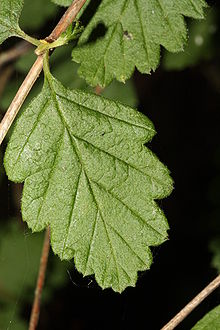- Holodiscus discolor
-
"Oceanspray" redirects here. For other uses, see Ocean Spray (disambiguation).
Holodiscus discolor Holodiscus discolor flowers (Anacortes, Washington) Scientific classification Kingdom: Plantae (unranked): Angiosperms (unranked): Eudicots (unranked): Rosids Order: Rosales Family: Rosaceae Subfamily: Maloideae or Spiraeoideae[2] Genus: Holodiscus Species: H. discolor[1] Binomial name Holodiscus discolor
(Pursh) Maxim.Holodiscus discolor, commonly known as ocean spray, creambush or ironwood, is a shrub of western North America.[3][4] It is common in the Pacific Northwest where it is found in both openings and the forest understory at low to moderate elevations.
Contents
Description
Holodiscus discolor is a fast-growing deciduous shrub growing to 5 m tall. Its alternate[5] leaves are small, 5–9 cm long and 4–7 cm broad, lobbed, juicy green when new. Cascading clusters of white flowers drooping from the branches give the plant its two common names. The flowers have a faint sweet, sugary scent. It bears a small, hairy fruit containing one seed which is light enough to be dispersed by wind.
Uses
Historically the plant has been used for many purposes. The Lummi used the flowers as an antidiarrheal and the leaves as a poultice. Many other tribes used the wood and bark for making tools and furniture. Noted for the strength of its wood, it was often used for making spears, arrows, bows, harpoons and nails. The wood, like with many other plants, was often hardened with fire and was then polished using horsetail. Several Indian tribes, such as the Stl'atl'imx, would steep the berries in boiling water to use as a treatment for diarrhea, smallpox, chickenpox and as a blood tonic.[4][6]
Ecology
Creambush, Holodiscus discolor, is found in a variety of habitats, from wet coastal forests to drier, cooler mountains further inland. It tends to grow in areas dominated by Douglas-fir. The plant is found in areas prone to wildfire, and it is often the first green shoot to spring up in an area recovering from a burn. Creambush is commonly found in chaparral communities, which burn periodically. It also may grow in areas swept clear by logging.
Holodiscus discolor is common in a variety of forest overstories. In the case of California Black Oak woodland, common understory associate species include Western poison-oak, Toyon and Coastal Wood Fern.[7]
See also
References
- ^ M. Casebeer (2004) Discover California Shrubs. Sonora, California: Hooker Press. ISBN 0-9665463-1-8
- ^ Potter, D., et al. (2007). Phylogeny and classification of Rosaceae. Plant Systematics and Evolution. 266(1–2): 5–43.
- ^ USDA Plants Profile (2008)
- ^ a b Pojar, Jim; Andy MacKinnon (1994). Plants of the Pacific Northwest. Lone Pine Publishing. p. 71. ISBN 1-55105-042-0.
- ^ Jepson Manual, 1993
- ^ Pojar; J, MacKinnon, A.; Alaback, P., et al. 1956/1994. Plants of the Pacific Northwest Coast: Washington, Oregon, British Columbia & Alaska, ISBN 978-1-55105-530-5
- ^ C. Michael Hogan (2008) California Black Oak Quercus kelloggii, Globaltwitcher.com, ed. Nicklas Stromberg
External links
 Media related to Holodiscus discolor at Wikimedia CommonsCategories:
Media related to Holodiscus discolor at Wikimedia CommonsCategories:- Maloideae
- Spiraeoideae
- Flora of Washington (state)
- Flora of Oregon
- Flora of Idaho
- Flora of California chaparral and woodlands
- Butterfly food plants
- Garden plants of North America
Wikimedia Foundation. 2010.


